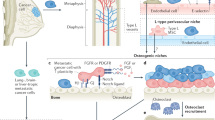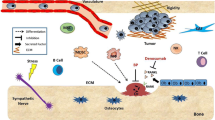Abstract
Lung cancer comprises a large variety of histological subtypes with a frequent proclivity to form bone metastasis; a condition associated with dismal prognosis. To identify common mechanisms in the development of osteolytic metastasis, we systematically screened a battery of lung cancer cell lines and developed three models of non-small cell lung cancer (NSCLC) with a common proclivity to form osseous lesions, which represented different histological subtypes. Comparative analysis revealed different incidences and latency times. These differences were correlated with cell-type-specific secretion of osteoclastogenic factors, including macrophage inflammatory protein-1α, interleukin-8 and parathyroid hormone-related protein, some of which were exacerbated in conditions that mimicked tumor–stroma interactions. In addition, a distinct signature of matrix metalloproteinase (MMP) activity derived from reciprocal tumor–stroma interactions was detected for each tumor cell line. Thus, these results suggest subtle differences in the mechanisms of bone colonization for each lung cancer subtype, but share, although each to a different degree, dual MMP and osteoclastogenic activities that are differentially enhanced upon tumor–stromal interactions.





Similar content being viewed by others
Abbreviations
- i.c.:
-
Intracardiac
- SCDC:
-
Single cell derived colonies
- TRAP:
-
Tartrate-resistant acid phosphatase
- qPCR:
-
Real time quantitative RT-PCR
- MMP:
-
Metalloprotease
- CM:
-
Conditioned medium
- NSCLC:
-
Non-small cell lung cancer
- SCLC:
-
Small-cell lung cancer
References
Jemal A, Tiwari RC, Murray T, Ghafoor A, Samuels A, Ward E, Feuer EJ, Thun MJ (2004) Cancer statistics, 2004. CA Cancer J Clin 54:8–29
Tuveson DA, Jacks T (1999) Modeling human lung cancer in mice: similarities and shortcomings. Oncogene 18:5318–5324
Ginsberg RJ, Kris MG, Armstrong JG (2001) Non-small cell lung cancer. Lippencott Williams and Wilkins, Philadelphia, PA
Coleman RE (1997) Skeletal complications of malignancy. Cancer 80:1588–1594
Delea T, Langer C, McKiernan J, Liss M, Edelsberg J, Brandman J, Sung J, Raut M, Oster G (2004) The cost of treatment of skeletal-related events in patients with bone metastases from lung cancer. Oncology 67:390–396
Fidler IJ (2003) The pathogenesis of cancer metastasis: the 'seed and soil’ hypothesis revisited. Nat Rev Cancer 3:453–458
Nguyen DX, Massague J (2007) Genetic determinants of cancer metastasis. Nat Rev Genet 8:341–352
Kakonen SM, Selander KS, Chirgwin JM, Yin JJ, Burns S, Rankin WA, Grubbs BG, Dallas M, Cui Y, Guise TA (2002) Transforming growth factor-beta stimulates parathyroid hormone-related protein and osteolytic metastases via Smad and mitogen-activated protein kinase signaling pathways. J Biol Chem 277:24571–24578
Kominsky SL, Doucet M, Brady K, Weber KL (2007) TGF-beta promotes the establishment of renal cell carcinoma bone metastasis. J Bone Miner Res 22:37–44
Yin JJ, Selander K, Chirgwin JM, Dallas M, Grubbs BG, Wieser R, Massague J, Mundy GR, Guise TA (1999) TGF-beta signaling blockade inhibits PTHrP secretion by breast cancer cells and bone metastases development. J Clin Invest 103:197–206
Guise TA, Yin JJ, Taylor SD, Kumagai Y, Dallas M, Boyce BF, Yoneda T, Mundy GR (1996) Evidence for a causal role of parathyroid hormone-related protein in the pathogenesis of human breast cancer-mediated osteolysis. J Clin Invest 98:1544–1549
Vicent S, Luis-Ravelo D, Anton I, Garcia-Tunon I, Borras-Cuesta F, Dotor J, De Las Rivas J, Lecanda F (2008) A novel lung cancer signature mediates metastatic bone colonization by a dual mechanism. Cancer Res 68:2275–2285
Chen JJ, Peck K, Hong TM, Yang SC, Sher YP, Shih JY, Wu R, Cheng JL, Roffler SR, Wu CW et al (2001) Global analysis of gene expression in invasion by a lung cancer model. Cancer Res 61:5223–5230
Onn A, Isobe T, Itasaka S, Wu W, O'Reilly MS, Ki Hong W, Fidler IJ, Herbst RS (2003) Development of an orthotopic model to study the biology and therapy of primary human lung cancer in nude mice. Clin Cancer Res 9:5532–5539
Kakiuchi S, Daigo Y, Tsunoda T, Yano S, Sone S, Nakamura Y (2003) Genome-wide analysis of organ-preferential metastasis of human small cell lung cancer in mice. Mol Cancer Res 1:485–499
Liu J, Blackhall F, Seiden-Long I, Jurisica I, Navab R, Liu N, Radulovich N, Wigle D, Sultan M, Hu J et al (2004) Modeling of lung cancer by an orthotopically growing H460SM variant cell line reveals novel candidate genes for systemic metastasis. Oncogene 23:6316–6324
Khanna C, Hunter K (2005) Modeling metastasis in vivo. Carcinogenesis 26:513–523
Yamaura T, Murakami K, Doki Y, Sugiyama S, Misaki T, Yamada Y, Saiki I (2000) Solitary lung tumors and their spontaneous metastasis in athymic nude mice orthotopically implanted with human non-small cell lung cancer. Neoplasia 2:315–324
Yang M, Hasegawa S, Jiang P, Wang X, Tan Y, Chishima T, Shimada H, Moossa AR, Hoffman RM (1998) Widespread skeletal metastatic potential of human lung cancer revealed by green fluorescent protein expression. Cancer Res 58:4217–4221
Zheng S, El-Naggar AK, Kim ES, Kurie JM, Lozano G (2007) A genetic mouse model for metastatic lung cancer with gender differences in survival. Oncogene 26:6896–6904
Jackson EL, Olive KP, Tuveson DA, Bronson R, Crowley D, Brown M, Jacks T (2005) The differential effects of mutant p53 alleles on advanced murine lung cancer. Cancer Res 65:10280–10288
Carney DN, Gazdar AF, Bepler G, Guccion JG, Marangos PJ, Moody TW, Zweig MH, Minna JD (1985) Establishment and identification of small cell lung cancer cell lines having classic and variant features. Cancer Res 45:2913–2923
Mitsudomi T, Steinberg SM, Nau MM, Carbone D, D'Amico D, Bodner S, Oie HK, Linnoila RI, Mulshine JL, Minna JD et al (1992) p53 gene mutations in non-small-cell lung cancer cell lines and their correlation with the presence of ras mutations and clinical features. Oncogene 7:171–180
Mitsudomi T, Viallet J, Mulshine JL, Linnoila RI, Minna JD, Gazdar AF (1991) Mutations of ras genes distinguish a subset of non-small-cell lung cancer cell lines from small-cell lung cancer cell lines. Oncogene 6:1353–1362
Hernandez I, Moreno JL, Zandueta C, Montuenga L, Lecanda F (2010) Novel alternatively spliced ADAM8 isoforms contribute to the aggressive bone metastatic phenotype of lung cancer. Oncogene 29:3758–3769
Eltarhouny SA, Elsawy WH, Radpour R, Hahn S, Holzgreve W, Zhong XY (2008) Genes controlling spread of breast cancer to lung “gang of 4”. Exp Oncol 30:91–95
Tester AM, Waltham M, Oh SJ, Bae SN, Bills MM, Walker EC, Kern FG, Stetler-Stevenson WG, Lippman ME, Thompson EW (2004) Pro-matrix metalloproteinase-2 transfection increases orthotopic primary growth and experimental metastasis of MDA-MB-231 human breast cancer cells in nude mice. Cancer Res 64:652–658
Zhao Q, Guo X, Nash GB, Stone PC, Hilkens J, Rhodes JM, Yu LG (2009) Circulating galectin-3 promotes metastasis by modifying MUC1 localization on cancer cell surface. Cancer Res 69:6799–6806
Roodman GD (2001) Biology of osteoclast activation in cancer. J Clin Oncol 19:3562–3571
Han JH, Choi SJ, Kurihara N, Koide M, Oba Y, Roodman GD (2001) Macrophage inflammatory protein-1alpha is an osteoclastogenic factor in myeloma that is independent of receptor activator of nuclear factor kappaB ligand. Blood 97:3349–3353
Iguchi H, Tanaka S, Ozawa Y, Kashiwakuma T, Kimura T, Hiraga T, Ozawa H, Kono A (1996) An experimental model of bone metastasis by human lung cancer cells: the role of parathyroid hormone-related protein in bone metastasis. Cancer Res 56:4040–4043
Kang Y, Siegel PM, Shu W, Drobnjak M, Kakonen SM, Cordon-Cardo C, Guise TA, Massague J (2003) A multigenic program mediating breast cancer metastasis to bone. Cancer Cell 3:537–549
Asou Y, Rittling SR, Yoshitake H, Tsuji K, Shinomiya K, Nifuji A, Denhardt DT, Noda M (2001) Osteopontin facilitates angiogenesis, accumulation of osteoclasts, and resorption in ectopic bone. Endocrinology 142:1325–1332
Bendre MS, Gaddy-Kurten D, Mon-Foote T, Akel NS, Skinner RA, Nicholas RW, Suva LJ (2002) Expression of interleukin 8 and not parathyroid hormone-related protein by human breast cancer cells correlates with bone metastasis in vivo. Cancer Res 62:5571–5579
Bendre MS, Margulies AG, Walser B, Akel NS, Bhattacharrya S, Skinner RA, Swain F, Ramani V, Mohammad KS, Wessner LL et al (2005) Tumor-derived interleukin-8 stimulates osteolysis independent of the receptor activator of nuclear factor-kappaB ligand pathway. Cancer Res 65:11001–11009
Thiolloy S, Halpern J, Holt GE, Schwartz HS, Mundy GR, Matrisian LM, Lynch CC (2009) Osteoclast-derived matrix metalloproteinase-7, but not matrix metalloproteinase-9, contributes to tumor-induced osteolysis. Cancer Res 69:6747–6755
Catena R, Luis-Ravelo D, Anton I, Zandueta C, Salazar-Colocho P, Larzabal L, Calvo A, Lecanda F (2011) PDGFR signaling blockade in marrow stroma impairs lung cancer bone metastasis. Cancer Res 71:164–174
Yin JJ, Pollock CB, Kelly K, Kakonen SM, Selander KS, Chirgwin JM, Burns S, Rankin WA, Grubbs BG, Dallas M et al (2005) Mechanisms of cancer metastasis to the bone. Cell Res 15:57–62
Iguchi H, Onuma E, Sato K, Ogata E (2001) Involvement of parathyroid hormone-related protein in experimental cachexia induced by a human lung cancer-derived cell line established from a bone metastasis specimen. Int J Cancer 94:24–27
Tisdale MJ (2002) Cachexia in cancer patients. Nat Rev Cancer 2:862–871
Zhou X, Wang JL, Lu J, Song Y, Kwak KS, Jiao Q, Rosenfeld R, Chen Q, Boone T, Simonet WS et al (2011) Reversal of cancer cachexia and muscle wasting by ActRIIB antagonism leads to prolonged survival. Cell 142:531–543
Acknowledgments
We are grateful to Dr. Pina for his valuable help assessing radiographs and the members of the Morphology Core facility and Animal Core Facilities. This work was supported by “UTE project FIMA” agreement, and RTICC C03/10, FIT-090100-2005-46, PI042284, PI070031, SAF-2009-11280 (to FL), Royo Foundation (SV), FPU (DL-R and KV), and Basque Government (IA). FL is also supported by funds from the I3 Program, “La Caixa Foundation”, and grants 67/2005, 09/2009 from the Government of Navarra. There are no conflicts of interest to disclose.
Author information
Authors and Affiliations
Corresponding author
Additional information
D. Luis-Ravelo, I. Antón and S. Vicent have contributed equally to this work.
Electronic supplementary material
Below is the link to the electronic supplementary material.
Rights and permissions
About this article
Cite this article
Luis-Ravelo, D., Antón, I., Vicent, S. et al. Tumor–stromal interactions of the bone microenvironment: in vitro findings and potential in vivo relevance in metastatic lung cancer models. Clin Exp Metastasis 28, 779–791 (2011). https://doi.org/10.1007/s10585-011-9409-5
Received:
Accepted:
Published:
Issue Date:
DOI: https://doi.org/10.1007/s10585-011-9409-5




